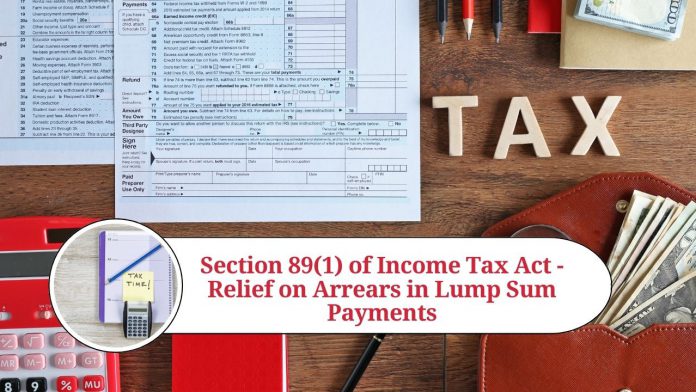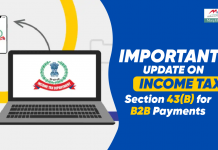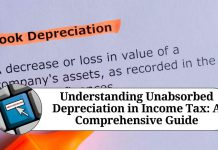Section 89(1) of the Income Tax Act, 1961 is an important provision that provides relief to taxpayers who receive arrears of salary or other payments in a lump sum in a financial year. The provision allows for the calculation of relief on the basis of the average tax rate applicable to the taxpayer over the past few years, thereby reducing the tax liability for the year in which the arrears are received. In this blog, we will discuss the provisions of Section 89(1) in detail and provide an overview of the Income Tax Act Calculator.
What is Section 89(1) of the Income Tax Act?
Section 89(1) of the Income Tax Act provides for relief to taxpayers who receive arrears of salary or other payments in a lump sum. The provision allows for the calculation of relief on the basis of the average tax rate applicable to the taxpayer over the past few years. This is done in order to reduce the tax liability for the year in which the arrears are received. The relief under Section 89(1) is available to both salaried and non-salaried taxpayers.
Calculation of Relief under Section 89(1)
The relief under Section 89(1) can be calculated using the Income Tax Act Calculator. The calculator takes into account the arrears received by the taxpayer, the tax payable on the arrears as per the current tax rate, and the tax payable on the arrears as per the average tax rate of the past few years. The relief is then calculated as the difference between the two.
For example, let us assume that a taxpayer receives arrears of Rs. 10 lakhs in the financial year 2021-22. The tax payable on the arrears as per the current tax rate is Rs. 3,09,000. However, if the taxpayer had received the arrears over the past few years, the tax payable would have been different due to the different tax rates applicable in those years. Let us assume that the taxpayer’s average tax rate over the past three years was 20%. The tax payable on the arrears as per the average tax rate is Rs. 2,00,000. In this case, the relief under Section 89(1) would be Rs. 1,09,000.
Benefits of Section 89(1)
Section 89(1) provides relief to taxpayers who receive arrears of salary or other payments in a lump sum. The provision ensures that the taxpayer is not unfairly burdened with a high tax liability in the year in which the arrears are received. This is particularly beneficial for employees who receive arrears due to pay revisions or arrears of Dearness Allowance.
While Section 89(1) provides relief to taxpayers who receive arrears of salary or other payments in a lump sum, it is important to note that this relief is only applicable if the arrears are related to past years. If the arrears are related to the current year or the future, then the relief under Section 89(1) is not applicable.
Additionally, the relief under Section 89(1) is applicable only to the extent of the tax liability of the taxpayer. If the tax liability of the taxpayer is lower than the relief calculated under Section 89(1), then the relief will be restricted to the amount of tax liability.
It is also important to note that the relief under Section 89(1) is not automatic and needs to be claimed by the taxpayer by filing Form 10E along with the income tax return for the relevant year. Failure to file Form 10E may result in the denial of the relief.
Furthermore, the Income Tax Act Calculator can be used to calculate the relief under Section 89(1) for multiple financial years. This is particularly useful for taxpayers who have received arrears over multiple years and want to claim relief for each year.
It is important to note that Section 89(1) of the Income Tax Act applies not only to salaried employees but also to other taxpayers who receive arrears in a lump sum. This includes freelancers, self-employed individuals, and individuals receiving pension or gratuity payments.
Additionally, the relief under Section 89(1) is not limited to arrears of salary or other payments. It also applies to other lump sum payments such as voluntary retirement payments, commuted pension payments, and compensation payments received in connection with termination of employment.
Furthermore, while the relief under Section 89(1) is a useful provision for taxpayers, it is important to consider the impact of the relief on other tax provisions. For example, claiming relief under Section 89(1) may impact the taxability of other income, such as income from house property, capital gains, or income from other sources.
It is also important to ensure that the taxpayer’s income tax return reflects the correct amount of income and tax liability after claiming relief under Section 89(1). Incorrect filing of the income tax return may result in penalties or interest charges.
Conclusion
Section 89(1) of the Income Tax Act is an important provision that provides relief to taxpayers who receive arrears of salary or other payments in a lump sum. The provision allows for the calculation of relief on the basis of the average tax rate applicable to the taxpayer over the past few years, thereby reducing the tax liability for the year in which the arrears are received. The Income Tax Act Calculator can be used to calculate the relief under Section 89(1). This provision is beneficial for employees who receive arrears due to pay revisions or arrears of Dearness Allowance.
Read more useful content:
- section 145 of income tax act
- section 10e of income tax act
- section 9 of the income tax act
- section 94b of income tax act
- section 206aa of income tax act
Frequently Asked Questions (FAQs)
What is Section 89(1) of the Income Tax Act?
Section 89(1) of the Income Tax Act provides relief to taxpayers who receive arrears of salary or other payments in a lump sum.
Who can claim relief under Section 89(1)?
Any taxpayer who receives arrears of salary or other payments in a lump sum can claim relief under Section 89(1).
How is the relief under Section 89(1) calculated?
The relief under Section 89(1) is calculated on the basis of the average tax rate applicable to the taxpayer over the past few years.
How can I claim relief under Section 89(1)?
You can claim relief under Section 89(1) by filing Form 10E along with your income tax return for the relevant year.
Is the relief under Section 89(1) automatic?
No, the relief under Section 89(1) is not automatic and needs to be claimed by the taxpayer.
Is the relief under Section 89(1) applicable only to arrears of salary?
No, the relief under Section 89(1) is not limited to arrears of salary. It also applies to other lump sum payments such as voluntary retirement payments, commuted pension payments, and compensation payments received in connection with termination of employment.
Is the relief under Section 89(1) applicable to future arrears?
No, the relief under Section 89(1) is applicable only to arrears related to past years.
Can the relief under Section 89(1) be claimed for multiple financial years?
Yes, the relief under Section 89(1) can be claimed for multiple financial years.
Does claiming relief under Section 89(1) impact the taxability of other income?
Yes, claiming relief under Section 89(1) may impact the taxability of other income, such as income from house property, capital gains, or income from other sources.
What should I do if I have received arrears in a lump sum?
If you have received arrears in a lump sum, you should consult a tax professional to determine whether you are eligible for relief under Section 89(1) and how to claim the relief.




















